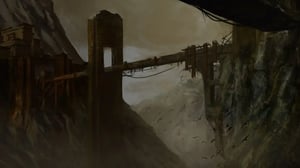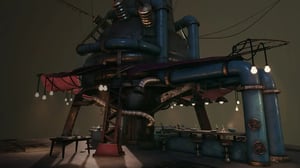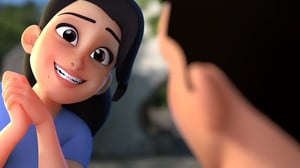
Environment Designer
Student work by Diomel Chaves
TABLE OF CONTENTS
What does an environment designer do?
Environment designers (or environment artists) are world builders working from a design brief or script to bring an imaginary or realistic universe to life. They create a mood, express style, and provide context. They are a type of concept artist and their work is often used as a base for building practical and 3D virtual sets.
A knowledge of topography, architecture, cityscapes, geography, and landscape is crucial to the craft of environmental design.
In the video games industry, Environment Designers often correlate with Level Designers, and increasingly specialize in the complex task of creating the backdrop to a story.
They create mood, express style, and give context to worlds that characters inhabit. They also function to facilitate the many moving parts of an animation or video game.
The Environment Design element of 3D animation development is becoming ever more sophisticated as players demand more heightened experiences from gameplay, with some environments expressed as characters in themselves. The Environmental Designer imagines worlds that service the storyline and contribute to the immersive nature of the game.
Environment designer job description
The role of the Environmental Designer is to create the worlds of animated films, TV shows, and video games. They work from scripts, concept art, and design briefs to bring the backgrounds, layouts, and environments to life from abstract concepts and descriptions.
Their task is to build the interior logic of the world into their designs and visualize all the possibilities of those worlds for the characters to inhabit, presented in either 2D or 3D.
Expressing narrative through virtual landscapes and gamescapes is also an important part of the role. Environmental Designers are visual storytellers, infusing the backdrop with story or gameplay elements.
Role & responsibilities of an environmental designer in film, TV, and video games:
- Liaising with animators, directors, and developers regarding the stylistic and story elements of the game or animation
- Researching resources and references for the project
- Designing environmental concept art or illustrations
- Producing a series of diverse interpretations of artwork for review
- Revising artwork until signed off
- Designing dramatic story moments from the script
- Collaborating with animators and/or game artists to create a virtual 3D environment that works with characters and assets
- Working within the constraints of budget and technologies
- Adhering to the production schedule
- Maintaining project documentation
- Expressing mood and tone in concept art
- Working with storyboard artists to incorporate layouts into scenes and sequences

How much does an environment designer make?
The average salary of an environment designer for film and games ranges from USD $68,000 to USD $103,000. (Source: Glassdoor)
To learn more about this field, visit: What is Digital Illustration? or What is Concept Art?
Skills required to become an environment designer
Environment Designers need to have a strong sense of perspective because a virtual world that is not immersive and true to reality will not work, jolt the viewer’s eye, destroy the suspension of disbelief and remove them from the story.
Environment Designers need to work fast to meet the requirements of the production pipeline, yet their work early in the project is vital.
Film and game studios may look for the following skills in environment designers:
- Training in digital painting, computer graphics, computer animation, or art
- Caricature and design skills
- Mastery of architectural and organic forms
- Strong knowledge of geography, architecture, and the laws of physics
- Ability to imagine expansive worlds that characters and objects can interact and move around in
- Stylistic versatility
- Good communication skills
- Ability to visualize natural terrains, cityscapes, sci-fi worlds, etc in intricate detail
- Strong understanding of texturing
- Experience in creating photorealistic environments
- Solid understanding of visual language - texture, color, dimension, scale, perspective, shade, composition, depth of field, proportion, spatial awareness, etc
- Technical drawing skills
- Excellent time management skills, ability to consistently meet deadlines
- Team player, skilled at working independently
- Maintaining production documentation
- Knowledge of the animation and/or game development processes
What software and tools do environment designers use?
Environment Designers may do their initial drawings using mixed media such as pen, paper, ink, paint, etc but all final artwork is delivered digitally.
They will also work with various reference materials such as photography, geographical and political maps, architectural drawings, botanical elements, road structures, city planning layouts, etc. Some textures may be scanned from real-world sources and others created from scratch.
Environment designers may need knowledge of a combination of the following software:

Maya is a comprehensive 3D animation software used for creating detailed models, animations, and visual effects. It's popular in film, TV, and game development for its powerful tools.

Unreal Engine is a 3D computer graphics game engine developed by Epic Games, first showcased in the 1998 first-person shooter video game Unreal

Maxon ZBrush is a digital sculpting tool that combines 3D/2.5D modeling, texturing and painting

Adobe Photoshop is a raster graphics editor developed and published by Adobe for Windows and macOS. It was created in 1987 by Thomas and John Knoll

The largest animation and gaming studios from around the world choose Harmony to produce the highest quality animation, setting the standard for creative storytelling.

Unity is a cross-platform game engine developed by Unity Technologies, first announced and released in June 2005 at Apple Worldwide Developers Conference
How to become an environment designer
Download software
Download free digital art software like Gimp, Krita, Sketchpad, FireAlpaca, and ArtWeaver to start practicing.
Practice
Sharpening your skills helps you grow and become more confident and reliable.
- Develop a solid understanding of art fundamentals—line, color, light, values, shape, composition, and perspective.
- Be observant of real-world references like people, creatures, and places which you can use as inspiration.
Build skills
Build the skills companies are listing on job sites. For more support, enroll in a reputable course. CG Spectrum’s concept art courses include mentorship from award-winning industry pros, an industry-led curriculum, and career services.
- Learn how to interpret a brief and execute feedback
- Familiarize yourself with the VFX and video game pipelines and how your work will be used
- Regularly practice art fundamentals and digital painting techniques
Watch trends
Online tutorials, webinars, etc., can keep your skills fresh.
Attend conventions
Use conventions to network, meet likeminded people, and be inspired. This is how award-winning Illustrator Eric Wilkerson got his first professional book cover illustration commission after college graduation.
Network
Networking is vital to getting your name and skills recognized and meeting experts who can offer advice or even jobs. Familiarize yourself with the industry and build your community—publishing houses, authors, and illustrators.
Share work
Social media is great for showcasing work, building an audience, having your work shared by others, and seen by potential clients and collaborators.
Presentation
Your portfolio is how you will market your services. Make your work presentable and user-friendly to impress prospective clients.
Collaborate
Know someone designing a game who needs character art? Collaborating with your peers is not only fun, but it can also help you create more polished work for your portfolio.
Intern
Internships at VFX, game, or publishing studios can help you break into the industry. It’s one way to gain hands-on experience, network, and experience studio life.
Join competitions
Practice your skills and create portfolio pieces by participating in contests on platforms like The Rookies and ArtStation.
For further info on the skills and qualifications that will help you break into the illustration industry, why not check out our comprehensive guide?

Ready to Start Your Film & Games Journey?
Download our course guide to see how we can help you on your pathway to your dream career.Tips to break into the environment designer industry
Your portfolio should show you understand the foundations of art while also establishing your own personal style. According to professional Illustrator Eric Wilkerson, your portfolio needs to demonstrate consistency while ensuring it’s tailored to the right audience. Other tips include:
- Quality over quantity! Revise older work to meet your current standards
- Only include your best. Work in progress is fine
- Seek inspiration from professional artists’ portfolios
- Center on one art genre for cohesion
- If using a PDF, add chapters for easy viewing
- Use a platform that allows you to update your work easily (e.g., ArtStation, The Rookies, or Behance)
- Aim for a clean, intuitive, gallery-style website with enlargeable thumbnails
- Don’t overcrowd your homepage —5 images max
- Optimize your images and ensure they load properly
- Present each piece with a brief explanation (concept, rationale, brief)
- Show process, sketches, roughs, and reference
- If necessary, create mockups of how your art would look in various formats
- Triple-check for errors (layout, framing, spelling, etc.)
- Get feedback from at least 3 mentors or industry pros before publishing
- Feature both your commercial and personal art
- Keep your ‘about’ page concise; it can be less formal
- Share your finished portfolio on your social channels
Additional resources to help you get started as an environment designer:
- Check out the How to become a digital illustrator webinar
- Watch 10 Must-Have Soft & Hard Skills For Artists Working From Home
- Explore Adobe Photoshop’s free tutorials
- Visit Matt Kohr’s website Ctrl+Paint for info, reference, and tutorials
- Watch Sinix Design’s YouTube channel
- Sign up to art and design website Creative Bloq
- Join Theoretically’s Character Art School discord channel
- Use Anatomy for Sculptors’ free 3D écorché reference tool
- Warm up with Drawabox’s basic drawing exercises
- Participate in ArtStation or The Rookies’s art challenges to build up your portfolio
- Get inspired by Imagine FX magazine’s showcase page
- Enter online competitions like Spectrum: The Best in Fantastic Art
- Read Big Bad World of Concept Art for Video Games by Elliott J. Lilly
- Read Art Fundamentals: Theory and Practice

Industry Pathways
Ehsan Ebrahimzadeh, Head of Department for 3D Modeling at CG Spectrum, tells his story about how he broke into 3D Modeling and became a Senior Environment Artist at Bethesda Studios. From carving out his own game studies in his home country of Iran, to moving to the US to work on projects at Arcane and Bethesda Studios, hear Ehsan's best tips and advice for aspiring 3D modelers and what it was like to meet one of his industry idols face-to-face in a job interview.


